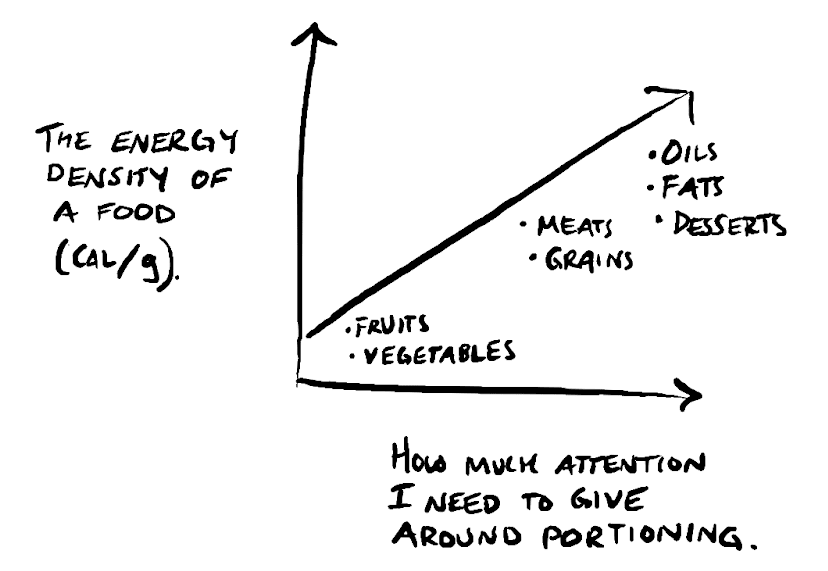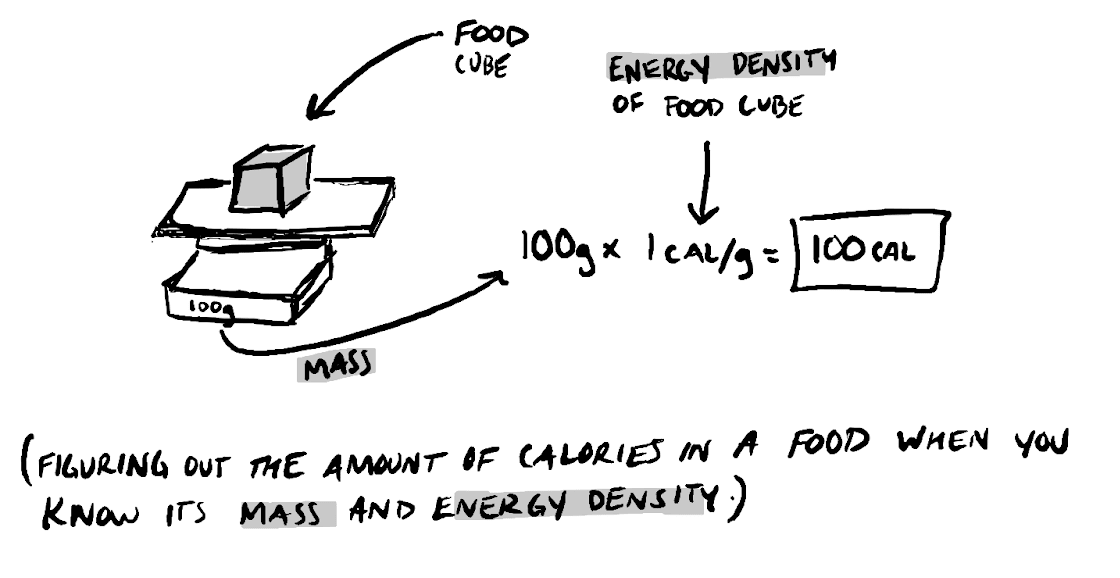Set down a baseline energy density.
Establishing a reference point will help you decide what food to eat and how much of it you want to eat.

My baseline is 1 cal/g. There's nothing special about 1 cal/g, it's merely convention. Like many conventions, it's useful. You may need a different baseline. Regardless of what baseline you need, you need one.

Here’s a list of foods and their energy densities:
| Name | cal/g |
|---|---|
| Olive oil | 8.84 |
| Butter | 7.17 |
| Peanut butter | 5.88 |
| Potato chips | 5.36 |
| Crackers | 5.03 |
| Granola bar | 4.71 |
| An oat-based cereal | 3.76 |
| 80/20 Ground beef | 2.72 |
| Pork loin | 2.42 |
| Chicken breast | 2.39 |
| Long-grain white rice (cooked) | 1.3 |
| baseline 1.0 cal/g | |
| Banana | 0.89 |
| Potato | 0.77 |
| Mango | 0.6 |
| Apple, pear | 0.52 - 0.58 |
| Carrot | 0.41 |
| Most winter squashes | 0.30-0.45 |
| Strawberry | 0.36 |
| Cabbage | 0.25 |
| Zucchini | 0.17 |
| Lettuce | 0.15 |
| Water | 0 |
| Ice water | -0.08* |
Low-energy foods are cheap real estate. They fill up stomach space with only a few calories. I can put one cup of granola in my stomach for 360 calories. But, for the same price of 360 calories, I could put three or four apples in there or 17 cups of zucchini.

Calories, mass, and energy density in a 1 cup serving:
| 1 cup serving | Calories | Mass (grams) | Energy Density (cal/g) |
|---|---|---|---|
| Zucchini | 21 | 124 | 0.17 |
| Cabbage | 22 | 89 | 0.25 |
| Watermelon | 46 | 152 | 0.3 |
| Squash | 63 | 140 | 0.45 |
| Apple | 65 | 125 | 0.52 |
| Granola cereal | 360 | 83 | 4.33 |
| Peanuts | 828 | 146 | 5.67 |
| Butter | 1627 | 227 | 7.17 |
Calories are units of measurement, like inches or feet. Units of measurement describe objects. If a carrot measures 9 inches long, you know something about it. A calorie is a unit measuring the energy content of food.
Calling a calorie count high is like calling an object long. We moved beyond measuring calories and inches and entered the realm of comparison. When you have two measurements then you can make new information, such as this food is more caloric than that food. Nutrition facts can't do this for us. They only provide data points. Data points are best when incorporated into a larger structure, like nails and planks.

After years of using a food scale, I've gotten good at "eyeballing" the caloric content of a food. When my food nears my 1 cal/g baseline, I can’t rely on my eyeballs. It's difficult to spoon a 3/4 cup of rice on a large plate or one tablespoon of oil on a flat pan.

When you have a reference point, you always have something to compare a portion of food against. If you are thinking about eating a bag of chips, you’ll know that it’s probably around 4-5 calories per gram, which is significantly higher than your reference point (assuming your baseline is 1 cal/g). You can eat the chips, but you can’t eat them without knowing that you’re eating caloric food.